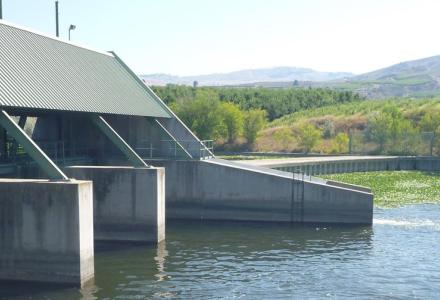
Thanks to the annual installation of an ice boom for the winter, large masses of ice are kept from flowing down the Niagara River, protecting property, the shoreline, and preventing water intakes from jamming at hydroelectric plants.
The Lake Erie-Niagara River Ice Boom has been installed each fall since 1964 to accelerate the formation and stabilization of the natural ice arch, and reduce the frequency and duration of ice runs from Lake Erie into the Niagara River.
By reducing these ice runs, or ice floating down river, the boom diminishes the probability of large-scale ice blockages. These blockages in the river can cause flooding, damage to shoreline property, and a reduction in flow of water to the hydro-electric power plant intakes down river near Niagara Falls.
The boom’s goals can be challenging during the winter months, when sub-zero temperatures produce an ice cover on Lake Erie that can be pushed around by winds to produce ice accumulations of up to 12 feet thick.
The IJC’s International Niagara Board of Control monitors the installation and removal of the ice boom as mandated by the IJC’s 1967 Order of Approval.
A working committee of personnel from the U.S. Army Corps Engineers, Buffalo District; Environment and Climate Change Canada; New York Power Authority; and Ontario Power Generation (OPG) assists in the effort.

The ice boom is owned and operated by the New York Power Authority and Ontario Power Generation and both are responsible for its installation and removal. The ice boom was constructed using timbers. It was fully converted to steel pontoons for the 1997-98 ice season. Converting to steel pontoons improved the ice boom’s buoyancy, making it more resistant to ice overtopping it, and reduced maintenance costs.
The ice boom consists of 22 spans. The first four are located between Buffalo Harbor’s inner and outer breakwater, and constructed using 16, 15-foot-long mini pontoons. The remainder of the boom is constructed using a series of steel pontoons each 30-feet-long and 30 inches in diameter.
Each span is built using up to 10 pontoons, anchored to the bottom of the lake at 400 foot intervals by 2.5 inch steel cables. When in position, the 8,800-foot ice boom stretches across the outlet of Lake Erie, just southwest of the city of Buffalo’s water intake crib.

Under the IJC Order of Approval, installation of the ice boom can begin as early as Dec. 16 or when Lake Erie water temperature, as measured at the city of Buffalo’s water intake crib (at a depth of 30 feet), reaches 39 degrees Fahrenheit.
The Order of Approval also requires that the ice boom be removed by April 1. However, its removal may be delayed if the ice cover in the eastern section of Lake Erie is greater than 250 square miles or the downstream conditions would be negatively impacted by the boom’s removal.
Ice monitoring efforts by the working committee include helicopter flights on the eastern end of Lake Erie to determine the thickness of the lake ice. Observation of ice cover through satellite imagery, information from the Canadian and U.S. National ice services, and ice survey flights conducted over Lake Erie using a fixed wing aircraft are other methods used to determine when the ice boom can be removed.
The average opening date for the ice boom is April 3. The earliest it has been opened was Feb. 28, 2012, and the latest May 3, 1971.
During the 2015-16 season, the boom was installed on Dec. 16 and removed on March 8.





